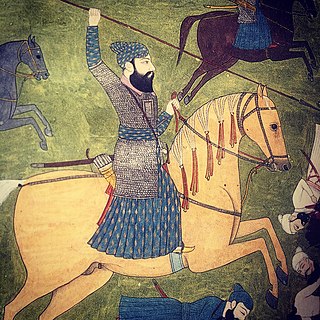Dal Khalsa was the name of the combined military forces of 11 Sikh misls that operated in the 18th century (1748–1799) in the Punjab region. It was established by Nawab Kapur Singh in late 1740s.

Bhai Mati Das, along with his younger brother Bhai Sati Das were martyrs of early Sikh history. Bhai Mati Das, Bhai Dayala, and Bhai Sati Das were executed at a kotwali (police-station) in the Chandni Chowk area of Delhi, under the express orders of Emperor Aurangzeb just before the martyrdom of Guru Tegh Bahadur. Bhai Mati Das was executed by being bound between two pillars and cut in two.
Sadhaura is a town, near Yamunanagar city with Municipal Committee in Yamunanagar district in the Indian state of Haryana. The city of Yamunanagar, it is of great historic significance. Sadhaura is very old town many historical temples/Dargah are there like Manokamna Temple, Laxmi narayan Temple, Roza Peer Dargah are some famous places in Sadhaura.
Samana is a town and a municipal council, nearby Patiala City in Patiala district in the Indian state of Punjab.

Sirhind is the older name of Fatehgarh Sahib, a city and Sikh pilgrimage site in Punjab, India. It is situated on the Delhi to Lahore Highway. It has a population of about 60,851 . It is now a district headquarters in the state of Punjab; the name of the district is Fatehgarh Sahib.

Banda Singh Bahadur, was a Sikh warrior and a general of the Khalsa Army. At age 15, he left home to become an ascetic, and was given the name Madho Das Bairagi. He established a monastery at Nānded, on the bank of the river Godāvarī. In 1707, Guru Gobind Singh accepted an invitation to meet Mughal Emperor Bahadur Shah I in southern India, he visited Banda Singh Bahadur in 1708. Banda became disciple of Guru Gobind Singh and was given a new name, Gurbaksh Singh(as written in Mahan Kosh), after the baptism ceremony. He is popularly known as Banda Singh Bahadur. He was given five arrows by the Guru as a blessing for the battles ahead. He came to Khanda, Sonipat and assembled a fighting force and led the struggle against the Mughal Empire.
Lohgarh is a historic town in Bilaspur tehsil of Yamunanagar district of Haryana in India. It was the capital of First Sikh State under Baba Banda Singh Bahadur from 1710 to 1716.

Binod Singh, a Trehan Khatri and a descendant of Guru Angad, was an army man and disciple of Guru Gobind Singh and was among few Sikhs who accompanied him to Nanded in 1706. In Budha Dal Chronicles, Guru Gobind Singh made Baba Binod Singh the head of the Khalsa.

Baba Baj Singh, also known as Baj Bahadur, was a Sikh general, governor, scholar and martyr from present-day India.
The siege of Sirhind was fought between the Mughal Empire and Sikh forces in 1710. The Sikhs besieged, stormed, captured, plundered and razed the city of Sirhind after defeating and beheading Wazir Khan in the Battle of Chappar Chiri.
The siege of Jalalabad occurred in 1710 between the Mughal forces of Jalal Khan and the Sikh forces of Banda Singh Bahadur. Banda Singh Bahadur attacked the Mughal stronghold of Jalalabad. The army opposing Banda Singh was composed of a sizeable number of the Mughal zamindars and shurafa, including many Sadat, Banda Singh Bahadur repelled Mughal and Pathan forces after four days from the battlefield and back into the town, but failed to capture the town and withdrew.
The Battle of Basoli was fought between the Mughal Empire and the Sikhs.

The Battle of Chappar Chiri, also called Battle of Sirhind, was fought between Mughal Empire and the Sikhs on 12 May 1710 at Chappar Chiri, located 20 kilometers from Sirhind.
The Battle of Sadhaura was fought between Sikhs and the Mughal, Sayyid, and Shaykh forces in Sadhaura in 1710. The imperial forces were defeated and took refuge behind the city's walls. Banda's forces captured the fort and levelled it to the ground. It resulted in a victory for the Sikhs where Banda Singh Bahadur defeated Osman Khan.

The Battle of Rahon was fought between Sikhs and Mughal Empire on 11 October 1710.

The Battle of Sonipat was fought between Sikhs and the Mughal Empire in 1709. It was the first significant battle during Banda Singh Bahadur's conquests.

Fateh Singh was a warrior in Sikh history. He is known for beheading Wazir Khan who was the Mughal Governor of Sirhind, administering a territory of the Mughal Empire between the Sutlej and Yamuna rivers. Wazir Khan was infamous for ordering the execution of the two young sons of Guru Gobind Singh, Sahibzada Fateh Singh and Sahibzada Zorawar Singh in 1704.
The Battle of Saharanpur was fought between the Sikh and Gujjar forces led by Banda Singh Bahadur and the Mughal forces of Saharanpur
The Battle of Kapuri was fought in 1709 by Sikh forces led by Banda Singh Bahadur and Mughal forces led by Qadam-ud-din.

The First Sikh State was a breakaway and short lived sovereign Sikh state during the 18th century in the Punjab region of the Indian subcontinent that existed from 1709 to 1715. It was established by Banda Singh Bahadur after the Battle of Samana and lasted until his defeat in the Battle of Gurdas Nangal.









